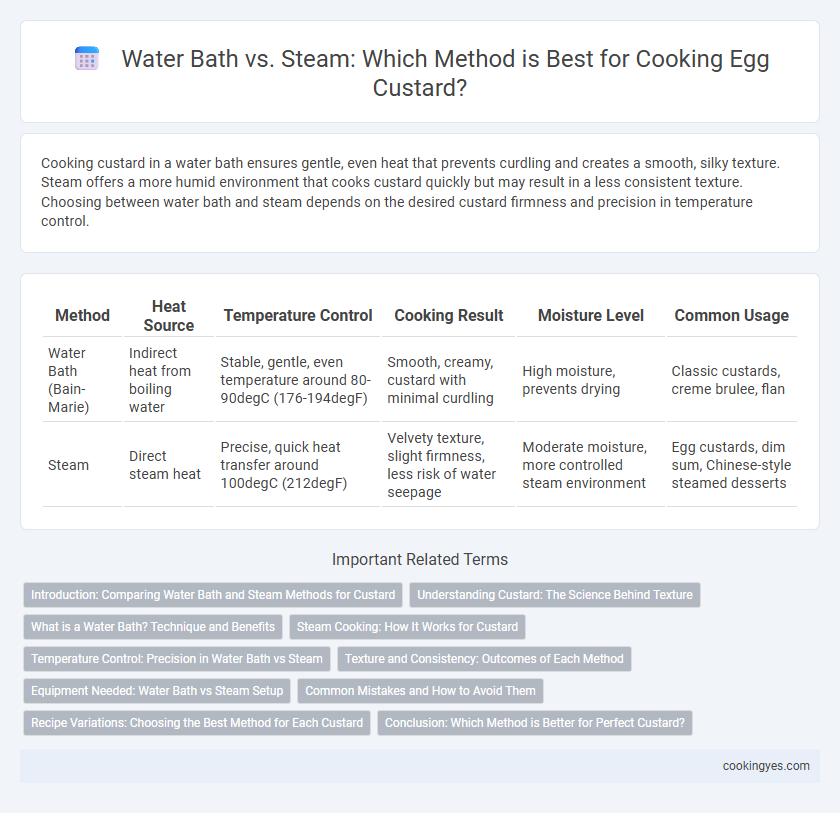Cooking custard in a water bath ensures gentle, even heat that prevents curdling and creates a smooth, silky texture. Steam offers a more humid environment that cooks custard quickly but may result in a less consistent texture. Choosing between water bath and steam depends on the desired custard firmness and precision in temperature control.
Table of Comparison
| Method | Heat Source | Temperature Control | Cooking Result | Moisture Level | Common Usage |
|---|---|---|---|---|---|
| Water Bath (Bain-Marie) | Indirect heat from boiling water | Stable, gentle, even temperature around 80-90degC (176-194degF) | Smooth, creamy, custard with minimal curdling | High moisture, prevents drying | Classic custards, creme brulee, flan |
| Steam | Direct steam heat | Precise, quick heat transfer around 100degC (212degF) | Velvety texture, slight firmness, less risk of water seepage | Moderate moisture, more controlled steam environment | Egg custards, dim sum, Chinese-style steamed desserts |
Introduction: Comparing Water Bath and Steam Methods for Custard
Water bath cooking evenly distributes heat by surrounding the custard container with hot water, minimizing temperature fluctuations and preventing curdling. Steam cooking uses moist heat from boiling water that creates a humid environment, allowing faster heat transfer and a smoother texture. Both methods provide gentle cooking environments ideal for delicate custard, but water baths offer more precise temperature control while steam accelerates cooking time.
Understanding Custard: The Science Behind Texture
Water bath cooking for custard ensures gentle, even heat distribution, preventing curdling and creating a smooth, creamy texture by maintaining a stable temperature around 80-85degC (176-185degF). Steam cooking introduces higher humidity and can rapidly cook custard, but the intense heat risks overcoagulation, leading to a grainy or rubbery consistency. Understanding the protein coagulation process in eggs at precise temperatures is crucial, as water baths offer better control to achieve the ideal custard texture.
What is a Water Bath? Technique and Benefits
A water bath, also known as a bain-marie, involves placing custard-filled containers in a larger pan of hot water before baking, ensuring gentle and even heat distribution. This technique prevents the custard from curdling or cracking by maintaining a consistent temperature, resulting in a smooth and creamy texture. Using a water bath also helps retain moisture and promotes uniform cooking, essential for delicate egg-based desserts.
Steam Cooking: How It Works for Custard
Steam cooking for custard uses moist heat to evenly transfer temperature around the egg mixture, preventing curdling and promoting a smooth, creamy texture. The surrounding steam maintains a consistent temperature typically around 100degC (212degF), ideal for gentle cooking without direct water contact. This method enhances custard's delicate structure by reducing the risk of overcooking and ensuring a uniform set.
Temperature Control: Precision in Water Bath vs Steam
Water baths offer superior temperature control by maintaining a consistent heat around the custard, typically at 80-85degC, preventing curdling or overcooking. Steam cooking reaches higher temperatures quickly but may cause uneven heat distribution, risking texture inconsistencies in the custard. Precision in temperature with water baths ensures smooth, creamy custard with minimal risk of separation.
Texture and Consistency: Outcomes of Each Method
Water bath cooking yields a smooth, creamy custard texture by gently and evenly distributing heat, preventing curdling or overcooking. Steam cooking produces a firmer, more set consistency with a slightly denser texture due to direct exposure to moist heat. Choosing between water bath and steam methods depends on the desired custard softness and mouthfeel.
Equipment Needed: Water Bath vs Steam Setup
Water bath cooking for custard requires a deep baking dish or roasting pan filled with hot water, along with oven-safe ramekins and a stable oven temperature control system. Steam cooking necessitates a reliable steamer or an oven with a steam function to maintain consistent humidity and temperature, ensuring even custard texture. Both methods demand precise temperature regulation equipment, but steam setups often require specialized appliances, while water bath setups leverage common kitchen tools.
Common Mistakes and How to Avoid Them
Using a water bath for custard cooking often leads to common mistakes like water seeping into the custard dish, which can cause a watery texture; to avoid this, tightly wrap the custard dish with foil to create a water-tight seal. Overheating steam can cause custard to curdle or become grainy, so maintaining a consistent low heat and monitoring the cooking time precisely is crucial. Avoid placing the custard dish too close to direct steam sources to ensure gentle, even cooking and a smooth, creamy texture.
Recipe Variations: Choosing the Best Method for Each Custard
Water bath cooking ensures gentle, even heat distribution for delicate custards like creme brulee and flan, preventing curdling and promoting a smooth texture. Steam cooking provides a moist environment ideal for firmer custards such as Chinese egg custard or chawanmushi, facilitating faster cooking without drying out. Selecting the method depends on the custard's desired consistency and regional recipe variations, with water baths favoring creamy custards and steam suiting silky, custard-based savory dishes.
Conclusion: Which Method is Better for Perfect Custard?
Water bath cooking offers more even heat distribution, minimizing the risk of curdling and producing a smoother, creamier custard texture. Steam cooking heats more quickly but can cause uneven temperature spikes, leading to a less consistent custard with potential overcooked spots. For achieving the perfect custard with delicate consistency and uniform cooking, the traditional water bath method remains superior.
Water bath vs Steam for custard cooking Infographic

 cookingyes.com
cookingyes.com